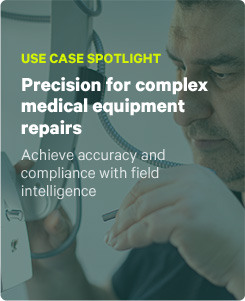If you’re looking for more information on how to design a comprehensive field service solution with TrueContext, then this blog post is for you. At EMPOWER’21, ProntoForms’ (now TrueContext’s) annual user conference, two of our brilliant product experts demonstrated the art of the possible. Ian Chamberlain (of Ian’s Insights articles in the TrueContext’s Community), Implementation Specialist, and Scott Daly, Senior Manager, Implementation Services, provided a walk-through of how our field team platform can be leveraged to handle all your technician, asset, and location-based field service needs. All you need is a simple workflow. Read on for a summary of this valuable presentation.
The components for a complete field service solution
Scott kicked off the session by detailing the components that make up a complete field service solution. He walked through all the individual components including:
- Forms. A key piece of this field service solution, smart, contextual forms guide technicians through complex work with service intelligence via easy-to-follow work instructions.
- Data sources. These are external sources of data brought into the form to provide context. Data sources make the form easier to fill out with pre-populated content, for example.
- Data destinations. Once you’ve determined what data techs need to collect while in the field, you’ll then need to establish data destinations. Define where you want this data to go once the form is submitted. This could be as simple as an email message, or you could send data to your back-end systems like Salesforce, SharePoint, or Oracle for example.
- Integrations. Like data destinations, you can also leverage secure communication and share data between TrueContext and a third-party system such as ServiceMax or Salesforce.
- Reporting. With TrueContext’s pre-packaged reporting dashboard, you’re set to track team productivity in the field, improve quality control, monitor compliance levels, and much more. We also connect to external analytics solutions such as Power BI and Tableau.
The 3 most common use cases for TrueContext’s field intelligence platform
There’s a deep well of opportunity when you consider how you can best support your operations with access to field data. Everything from installation and maintenance, inspections and audits, to safety and compliance, and billing and customer service — it’s all covered with TrueContext. The main types of use cases where we help companies succeed most commonly fall into three main categories:
Location. This includes site readiness, hazard assessment, customer satisfaction, and customer acceptance, among other use cases. - Technician. These use cases are primarily related to productivity, skills and knowledge, timesheets, tasks and procedures, and more.
- Asset. Use cases of this nature are focused on Service Work Orders, installation, preventative maintenance, calibration, and others.
We’ve established the components for a complete field service solution and the main types of use cases we tend to see. Now it’s time to go further into what this all means for a field service organization.
A quick review of TrueContext’s field intelligence solution
During this session, Ian walked attendees through the scenario of a complete field service solution. Please click here to watch the entire session, but read on if you’d like the Coles Notes version of this session.
Ian first walked through the Site Readiness Form. The form includes questions related to:
- the readiness of the job site
- information on the kind of work the customer requires
- the technician to dispatch the work to
- the job’s due date.
A Customer Feedback Form was also included in Ian’s scenario.
This Site Readiness Form is used as the entry point to gather information. It kicks off a dispatch to the technician specified in the form via a Dispatch Data Destination. Once the form is dispatched, it’s sent to the inbox of the TrueContext app. The action will be launched from the field techs’ inbox and contain pre-populated work order information.
The service work order Ian created was based on the same mobile form as mentioned above, with data pulled in from Salesforce Data Sources. Once the technician finishes their work, the form is sent off with all the information updated in the SharePoint list and Salesforce dashboard. The data makes its way back into Salesforce or any other backend system that’s been configured, without any delay.
Ian showcased how there are already custom objects set up automatically in Salesforce. These custom objects are used to predefine many of the data points you’re looking to gather and track in your Salesforce dashboard. You’ll gain insight into what’s happening with your accounts. You can drill into an account and see all the different submissions that have been put through for that one account. It even allows you to click on a PDF and view the real submission with all the answers and questions for that form.
Enhance your analytics and reporting capabilities with TrueContext
All the valuable information your techs have gathered helps with reporting and gives complete visibility into each phase of the work order process. TrueContext enables you to see what’s in flight, what’s outstanding, and the results of the completed inspections and work orders.
Power BI can also be used to quickly see what’s happening based on information gathered in the field. Key metrics can be pulled out and different data points can be viewed in your dashboards. For example, KPIs related to the total number of work orders, total jobs completed, what inspections have passed or failed, and a breakdown of the status of work orders can be viewed. Timesheets can be examined at a glance to see who’s doing the most amount of work, spending the most time on the site, and which customers are eating up the most time.
Conclusion
This informative demo showed how to use one simple form to collect a ton of information and use it in multiple places for different stakeholders. Examples of the wide variety of data that can be collected within TrueContext were showcased. How this information gets used in dashboards was also covered. While this was one specific use care and workflow mapped out using specific cloud and business systems, the same concepts apply whether you’re using Tableau or any other reporting tools. We have out-of-the-box connectors to make it very simple and easy to connect and get a real-time sense of the field service operations occurring in your company.
It’s easy to extend your reach into the field with connected mobile forms. For more information, connect with your account executive or customer success manager. They are more than happy to walk you through how to get up and running. They’re also skilled in looking for additional ways for you to leverage your TrueContext investment.



